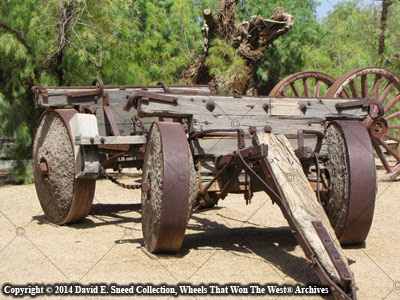During the eighteen and early nineteenhundreds, removing large quantities of timber from remote forests carried a lotof challenges. Nevertheless, heavyvehicle makers from those days built numerous designs just for thatpurpose. Eight wheel logging wagons,heavy-duty logging gears, carts, and even sleds were utilized within thisspecialized industry.
 |
| An early logging wagon with solid wood wheels on display at Furnace Creek in Death Valley. |
Years ago, I wrote an article for ourWheels That Won The West® website outlining the origins of a giant two-wheeleddesign referred to in a number of ways. The vehicle name often varied depending on the region of the country butsome of the titles it held included “Logging Wheels,” “High Wheels,” and “BigWheels.”
These massive logging carts wereengineered to transport large logs over demanding and difficult terrain. With wheel heights ranging from six to twelvefeet, these lumbering giants worked the woods throughout the U.S. Over the last few years, our archives haveacquired a number of 19th century materials highlighting these rarepieces. One of the makers in this groupof promotional resources is the Gestring (pronounced ‘Guess –string’) WagonCompany of St. Louis, Missouri. I wrotea fairly lengthy set of articles for Farm Collector magazine on this companyback in 2010. A few of the other makersin this trove of ephemera are the Wilson-Childs Wagon Works of Philadelpha,Pennsylvania… Studebaker Bros. of South Bend, Indiana… Electric Wheel Companyof Quincy, Illinois… Manning, Maxwell and Moore of New York… and perhaps themost legendary of all – Silas Overpak of Manistee, Michigan.
With most of the images and ephemeradating to well over a century ago, these original promotional pieces highlightdifferences between a variety of offerings. Features like Georgia rigging, ratchet lifts, and screw rigging withdogs (hooks) for holding the logs to be lifted were among the variety of designsshown. Tire widths could be as wide aseight inches, tongue configurations changed depending on whether the vehiclewas used by horses or oxen, and wholesale prices could range from $110 to over$200 in the late 1890’s. As timeprogressed, some of these Big Wheels were also drawn by steam traction engines.
Weight of a single 7 foot tall wheelwith 5 inch tire is listed by one builder as being around 600 pounds. Total weight of the entire design couldeasily register a ton or more. Otherspecifications from this literature include the notation that many High Wheeldesigns were engineered to carry from 100 to 4,000 feet of logs in a singleload. The timber could range in lengthfrom 12-100 feet. As shown in the photoabove, in a trip to Death Valley last year, we were able to get a firsthandlook at an original set of High Wheels. Like America, itself, the massive size of these wheels is a reminder ofthe challenges, opportunities, and potential rewards for those willing to rollup their sleeves and join the free enterprise system.
By the way… If you haven’t signed up to receive this weekly blog via email, just type in your address in the “Follow By Email” section above. You’ll receive a confirmation email that you’ll need to verify before you’re officially on board. Please don’t hesitate to let us know if we can be of assistance. We’re looking forward to your visits each week.


